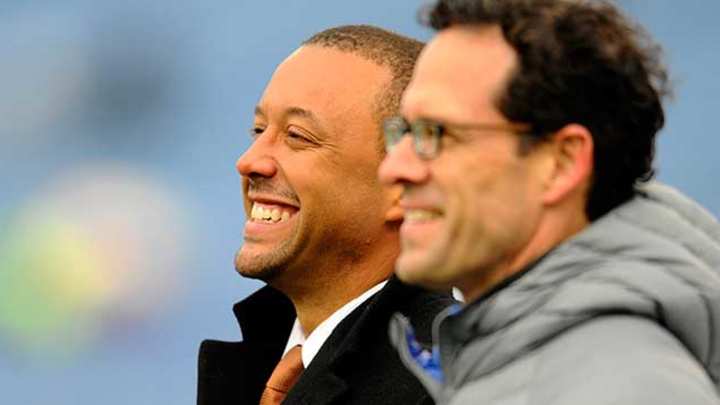The Browns’ Brock Osweiler Trade: Moneyball in Action

Brock Osweiler got traded to the Browns on Thursday. We still don’t know what team he’ll play for 2017. And Moneyball is the culprit.
Ever since Sashi Brown took over in Cleveland 14 months ago, and quickly imported former baseball executive Paul DePodesta, the assumption that the new brass would be borrowing analytical models from other sports and bringing them to the NFL has been made. In this case, the comparison is very valid.
This trade is pure Moneyball.
The Browns have hoarded assets. They traded the second pick in last year’s draft and dealt down again before actually selecting a player (Corey Coleman). They also let free agents like Mitchell Schwartz, Alex Mack, Travis Benjamin and Tashaun Gipson go, knowing comp picks would be coming back. And in doing so, they amassed the most cap room any team has had in the 24-year history of NFL free agency.
The windfall: $102 million in cap space, and 11 picks within the first six rounds of the 2017 draft, including five of the first 65 picks.
On Thursday they started utilizing their assets, mostly in conventional ways—getting free-agent linemen Kevin Zeitler and JC Tretter, and receiver Kenny Britt in the fold, and extending the deal of stalwart guard Joel Bitonio. And then they moved to use their cap space in another way—and flip it into another asset. In the trade with the Texans, Cleveland gets a second-round pick in 2018, a sixth-rounder in ’17 and Osweiler (and the $16 million he’s owed this year) in exchange for a 2017 fourth-rounder.
Moneyball in baseball is designed to find market inefficiencies, and one of those would certainly be how a big quarterback contract can hang around a team’s neck. The Browns saw that, in the way the Brock Osweiler contract has become an absolute albatross in Houston—and found an opening.
The result: They flipped late-round picks this year, and acquired a second-round pick next year to take on Osweiler’s contract. And they’re trying to find someone to take Osweiler off their hands now, while they eat a piece of his salary, to acquire something else (though it likely wouldn’t be much).
To be sure, the Texans had already begun the process of moving on from Osweiler. Owner Bob McNair said publicly early in the offseason that finding a solution at quarterback was a priority. And the fact is that, if the season started last Sunday, Tom Savage would’ve been ahead of Osweiler on the depth chart.
The issue, though, went a little deeper than that. Osweilier’s clashes with the staff late in the 2016 season made the idea of bringing him back in any capacity in 2017 uncomfortable at best. If the Texans cut him? Well, then they’d have to cut him a $16 million check, too, and such a move would push his cap number from $19 million to $25 million, making finding another option at quarterback even more difficult.
Tony Romo’s availability absolutely has been on Houston’s radar—he is considered a system fit for Bill O’Brien. But if the team’s financial flexibility were to shrink, so would the chances of actually landing Romo or any other big-ticket item at the game’s most important position.
In essence, the Texans, with the league’s No. 1 defense and a solid crew of skill players, were between a rock and a hard place with the quarterback situation. The Browns, to their credit, saw opportunity. And they struck.
I’d be surprised if we see Osweiler playing for the Browns in the fall, because this trade wasn’t about acquiring Osweiler. It was about taking advantage of an inefficiency elsewhere and leveraging an asset from it.
OK, so we went through all the unprecedented portfolio of ammunition the Browns took into this offseason, right? When I asked coach Hue Jackson about it on Saturday, he said, “It’s very exciting, but it’s pressure-packed too. You gotta get it right because these are opportunities to take this organization in a whole new direction.”
With this trade, the Browns didn’t acquire a quarterback. They simply created more opportunity for themselves—this time in 2018. They now have 10 picks in that draft, 14 months away, including three second-rounders and two fourth-rounders. Chances are they’ll eventually wind up with more than that. Of course, at some point this will have to be about selecting the right players with all those picks.
Draft capital and cap space don’t block and tackle. But having this much of it can certainly help in the search for guys who can.
Question or comment? Email us at talkback@themmqb.com.

Albert Breer is a senior writer covering the NFL for Sports Illustrated, delivering the biggest stories and breaking news from across the league. He has been on the NFL beat since 2005 and joined SI in 2016. Breer began his career covering the New England Patriots for the MetroWest Daily News and the Boston Herald from 2005 to '07, then covered the Dallas Cowboys for the Dallas Morning News from 2007 to '08. He worked for The Sporting News from 2008 to '09 before returning to Massachusetts as The Boston Globe's national NFL writer in 2009. From 2010 to 2016, Breer served as a national reporter for NFL Network. In addition to his work at Sports Illustrated, Breer regularly appears on NBC Sports Boston, 98.5 The Sports Hub in Boston, FS1 with Colin Cowherd, The Rich Eisen Show and The Dan Patrick Show. A 2002 graduate of Ohio State, Breer lives near Boston with his wife, a cardiac ICU nurse at Boston Children's Hospital, and their three children.
Follow AlbertBreer